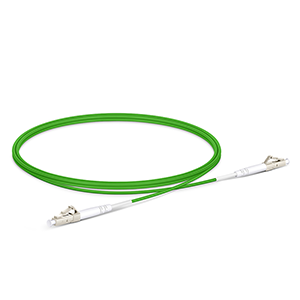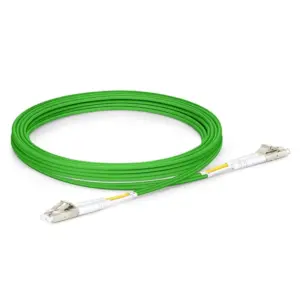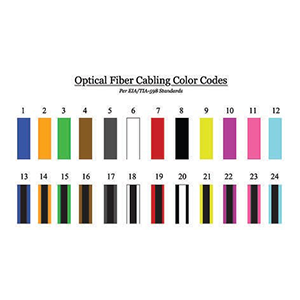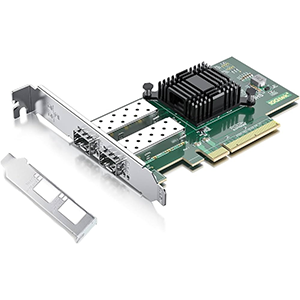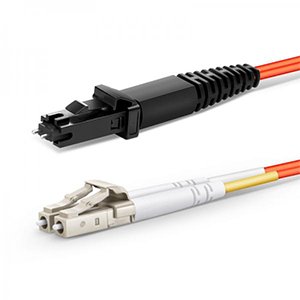As a new generation of multi-mode optical fiber transmission solution, OM5 optical fiber jumper has the characteristics of high-speed transmission, low attenuation and multi-purpose, providing faster and more reliable connections for modern data centers and communication systems.
This article will introduce the definition, structure and characteristics of OM5 optical fiber patch cord, and discuss its application in high-speed data centers and parallel optical communication systems. We will also discuss in detail the transmission performance of OM5 fiber optic patch cords, comparison with other fiber grades, deployment and maintenance considerations, and look forward to the development trend of OM5 fiber optic patch cords in future fiber optic networks.
Introduction to OM5 fiber optic patch cord
Definition and characteristics:
OM5 fiber optic patch cord is a multi-mode fiber optic patch cord used to transmit optical signals in data centers, local area networks, and other high-speed fiber optic communications applications. It uses multi-mode optical fiber transmission technology and can support high-speed, high-bandwidth data transmission.
The main features of OM5 fiber optic patch cords include:
-
High bandwidth: OM5 fiber optic patch cord can support higher data transmission rate and bandwidth requirements. It has enough bandwidth to transmit multiple channels of high-speed data, making it suitable for high-density data centers and network applications.
-
Multi-mode transmission: OM5 optical fiber jumper uses multi-mode optical fiber, allowing multiple light modes to be transmitted in the optical fiber. Multimode fiber is suitable for short-distance transmission, has a larger core diameter, and can accommodate multiple optical signal modes.
-
Color coding: OM5 optical fiber patch cord uses Wavelength Division Multiplexing (WDM) technology to achieve simultaneous transmission of multiple channels by color coding on optical signals of different wavelengths.
-
Low loss and low delay: OM5 optical fiber jumper has low optical signal loss and transmission delay. It provides high-quality signal transmission over short distances.
Multimode optical fiber classification:
Multimode fiber is classified according to its transmission performance and specifications, and OM5 is one of the grades.
OM5 level multi-mode optical fiber is further improved on the basis of OM4 level. It has higher bandwidth and transmission capacity. OM5 optical fiber adopts Wavelength Division Multiplexing (WDM) technology of multi-mode optical fiber, which achieves higher transmission capacity by using different wavelengths to send multiple optical signals into the optical fiber.
Features of OM5 fiber optic patch cords include:
-
Wavelength range: OM5 fiber supports the wavelength range from 850 nanometers to 953 nanometers, and is compatible with the wavelength requirements of OM3 and OM4 fibers.
-
Bandwidth: OM5 fiber optic patch cord has higher bandwidth capabilities and supports transmission rates of more than 100 Gbps.
-
Color coding: OM5 fiber realizes the transmission of multiple channels by using different wavelengths and color coding.
OM5 grade multimode optical fiber is suitable for applications requiring high-speed data transmission and high-density connections, and is especially widely used in data centers and LAN environments.
Structure and parameters of OM5 fiber optic patch cord
structure:
The structure and components of OM5 fiber optic patch cord are similar to other multimode fiber optic patch cords, and mainly include the following parts:
-
Optical fiber core: The core of OM5 optical fiber jumper is made of optical fiber material and is used to transmit optical signals. The diameter of the optical fiber core determines the transmission characteristics and bandwidth capabilities of the optical signal.
-
Cladding: The fiber core is surrounded by a cladding, which functions to protect the fiber core and provide a light transmission environment. The cladding is usually made of optical materials such as silicone.
-
Outer sheath: The outside of the fiber jumper is covered with an outer sheath to protect the fiber core and cladding and provide mechanical strength and tensile resistance. The outer sheath is usually made of polymer material such as PVC or LSZH.
parameter:
OM5 fiber optic patch cord has the following important parameters, which will affect its transmission performance and scope of application:
-
Core Diameter: The core diameter of OM5 optical fiber jumper is usually 50 microns (μm). A larger core diameter can accommodate more light modes and support higher bandwidth transmission.
-
Mode Field Diameter: The mode field diameter of OM5 optical fiber jumper is usually about 10.4 microns (μm). The mode field diameter indicates the propagation range of the optical signal in the optical fiber and affects the transmission loss and coupling efficiency.
-
Typical Attenuation: The typical attenuation of OM5 fiber optic patch cord is usually between 0.5 and 3.0 decibels (dB) per kilometer. Attenuation is the signal loss of optical signals during transmission. The lower the attenuation, the better the signal transmission quality.
-
Wavelength Range: The wavelength range of OM5 fiber optic patch cord is usually from 850 nanometers to 953 nanometers. This range is compatible with the wavelength requirements of OM3 and OM4 fiber and supports multi-channel transmission and color coding.
These parameters can vary based on the specific OM5 fiber optic patch cord product and manufacturer. When selecting and applying OM5 optical fiber jumpers, it is recommended to refer to the specification sheet and technical manual provided by the manufacturer to understand its specific parameters and performance characteristics.
Application areas of OM5 fiber optic patch cord
High-speed data center:
OM5 fiber optic patch cords are widely used in high-speed data center networks. Data centers often require high bandwidth and low latency solutions, and OM5 fiber optic patch cords can meet these needs. It can be used to connect high-speed communication links between devices such as servers, storage devices, network switches, and routers. The multi-mode transmission capabilities and high-bandwidth characteristics of OM5 fiber optic patch cords enable data centers to support large-scale data transmission and processing, improving overall network performance and efficiency.
Parallel optical communication:
OM5 optical fiber jumpers also play an important role in parallel optical communication systems. Parallel optical communication refers to achieving high-speed data transmission by transmitting multiple optical signal channels simultaneously. The multi-mode fiber structure and color coding technology of OM5 fiber optic patch cord make it an ideal choice in parallel optical communication systems. It can support simultaneous transmission of multiple high-speed channels to achieve greater transmission capacity and speed. In applications that require high-density connections and large-scale data transmission, such as supercomputers, high-performance computing and cloud computing centers, OM5 fiber optic patch cords can provide reliable data transmission and communication solutions.
In summary, OM5 fiber optic patch cords are widely used in high-speed data centers and parallel optical communications. Its high bandwidth, multi-mode transmission and low latency make it ideal for meeting large-scale data transmission and high-speed communication needs. With the continuous development of data centers and network applications, the application prospects of OM5 fiber optic patch cords will be broader.
Transmission performance of OM5 fiber optic patch cord
Transmission distance:
The transmission distance of OM5 fiber optic patch cords depends on several factors, including the quality of the fiber, the performance of the sending and receiving equipment, and the transmission standard used. Generally speaking, the maximum transmission distance supported by OM5 fiber optic jumpers in multi-mode fiber optic systems is usually between 100 meters and 400 meters.
It should be noted that the transmission distance is also affected by other factors, such as the quality of the optical fiber connection, the attenuation of the optical signal, the loss of the connector, etc. Therefore, in practical applications, it is very important to ensure the connection quality and correct installation method of fiber optic jumpers to achieve the best transmission distance.
Transmission rate:
OM5 fiber optic patch cord can support a variety of transmission rates, including but not limited to the following:
-
10Gbps: OM5 fiber optic patch cord can support 10Gbps data transmission rate, providing high-quality transmission within short distances (usually within 100 meters).
-
40Gbps and 100Gbps: OM5 optical fiber jumpers can also be used to support high-speed data transmission of 40Gbps and 100Gbps. In this case, parallel optical communication technology is usually used to achieve high-speed transmission by transmitting multiple optical signal channels simultaneously.
It should be noted that the transmission rate is also affected by other factors, such as the compatibility of the sending and receiving equipment, the support of optical modules, etc. Ensuring that fiber optic patch cords are compatible with corresponding equipment and transmission standards is key to achieving high-speed transmission.
In summary, OM5 fiber optic patch cords can provide high-quality data transmission over short distances (usually between 100 meters and 400 meters). It can support multiple transmission rates, including 10Gbps, 40Gbps and 100Gbps, etc. The specific transmission rate depends on the equipment and transmission standards used. In practical applications, ensuring the connection quality and correct installation method of fiber optic patch cords is crucial to achieve optimal transmission performance.
Comparison of OM5 fiber optic patch cords and other fiber grades
Performance comparison:
OM5 fiber optic patch cord has the following differences in performance compared to other multimode fiber grades (such as OM1, OM2, OM3, OM4):
-
Bandwidth: OM5 fiber optic patch cord has higher bandwidth capabilities. OM1 and OM2 optical fibers have lower bandwidth and are suitable for shorter distances and low-rate transmission. OM3 and OM4 optical fiber have relatively high bandwidth and support higher rate transmission, but OM5 optical fiber patch cord has more advantages in high-speed transmission.
-
Transmission distance: The transmission distance of OM5 optical fiber patch cord is relatively short during high-speed transmission. OM1 and OM2 optical fibers have shorter transmission distances at 10Gbps, while OM3 and OM4 optical fibers can support longer transmission distances. OM5 fiber optic patch cords provide high quality transmission over a range of 100 meters to 400 meters.
-
Wavelength range: OM5 fiber jumper has a wider wavelength range. OM1, OM2, OM3 and OM4 fibers are typically suitable for wavelengths of 850 nanometers, while OM5 fiber patch cords are capable of supporting wavelengths ranging from 850 nanometers to 953 nanometers.
Applicable scene:
When selecting OM5 fiber optic patch cords or other fiber grades, consider the following best practices:
-
OM1 and OM2 optical fiber jumpers: suitable for shorter distance and low-rate transmission scenarios, such as local area networks (LAN) and low-density data centers.
-
OM3 optical fiber jumper: suitable for medium-distance and medium-speed transmission scenarios, such as enterprise data centers and campus networks.
-
OM4 optical fiber jumper: suitable for longer distance and high-speed transmission scenarios, such as large data centers and high-performance computing.
-
OM5 optical fiber jumper: suitable for scenarios that require higher bandwidth and multi-channel transmission, such as high-speed data centers and parallel optical communication systems. OM5 fiber optic patch cords provide higher bandwidth and transmission rates over short distances and are suitable for applications requiring large-capacity data transmission.
To sum up, the choice of optical fiber grade should consider specific application requirements, including transmission distance, transmission rate and bandwidth requirements. OM5 fiber optic patch cords have advantages in scenarios requiring high bandwidth and multi-channel transmission, while other fiber grades are suitable for different ranges of transmission distance and rate requirements. In practical applications, it is recommended to select the most appropriate fiber grade based on specific needs and performance requirements.
Precautions for deployment and maintenance of OM5 fiber optic patch cord
Installation and connection:
When installing and connecting OM5 fiber optic patch cords, the following are some considerations:
-
Ensure the quality of fiber jumpers: Choose high-quality OM5 fiber jumpers to ensure transmission performance and signal quality.
-
Keep the fiber end face clean: Before connecting, make sure the fiber end face is clean and clean. Use appropriate cleaning tools and methods, such as pure non-woven cloth and fiber optic cleaner, and avoid touching the end face.
-
Correctly connect the fiber optic patch cord: When inserting the fiber optic connector into the corresponding interface, ensure correct alignment and push in gently to avoid excessive force. Make sure the connector is fully inserted and locked.
-
Avoid excessive bending and pulling: During wiring and installation, avoid applying excessive bending or pulling force to the fiber jumper to avoid fiber damage.
Maintenance and care:
The following are the key points on the maintenance and upkeep of OM5 optical fiber jumpers:
-
Clean the fiber end face regularly: Check and clean the connector end face of the fiber jumper regularly to ensure it is clean and free of contamination. Use appropriate cleaning tools and methods, such as fiber optic cleaning wands or cleaning cartridges.
-
Protect optical fiber connectors: Keep the protective cover or dust cap of the optical fiber connector to keep the connector end face clean and safe when not in use.
-
Avoid bending and pulling: During use and maintenance, avoid applying excessive bending or pulling force to the fiber jumper.
-
Prevent physical damage: Protect fiber patch cords from physical damage, such as pressure, squeezing, pulling, and dropping.
-
Regular inspection and testing: Regularly inspect and test the connection quality and performance of fiber optic patch cords to ensure their normal operation.
It is important to note that to ensure optimal performance and longevity of OM5 fiber optic patch cords, it is recommended to follow the vendor’s specific recommendations and operating manuals, as well as any applicable industry standards and specifications. Maintaining good maintenance and care habits can help improve the reliability and performance of fiber optic patch cords.
Please note that before performing any installation, connection, maintenance or service operations on fiber optic patch cords, it is recommended to consult the relevant operating manuals, documentation and guidance provided by the supplier to ensure correct operation and compliance with applicable safety regulations and standards.
Summarize:
As a multi-mode optical fiber transmission solution, OM5 optical fiber jumper has the characteristics of high-speed transmission, low attenuation and multi-purpose, and plays an important role in high-speed data centers and parallel optical communication systems. Its excellent transmission performance and adaptability make it an important choice in future optical fiber networks.
During deployment and maintenance, following correct installation and connection methods, and paying attention to maintenance and upkeep measures can ensure the stability and reliability of OM5 fiber optic patch cords. Looking to the future, with the continuous development of new generation standards and technologies, OM5 optical fiber jumpers are expected to further innovate and apply in the field of optical fiber networks, providing more advanced solutions for high-speed data transmission.
OM5 fiber optic patch cord FAQ
An OM5 patch cord is a type of fiber optic patch cord that is designed to support high-speed data transmission over multimode fiber optic cables. OM5 is a designation for a wideband multimode fiber (WBMMF) that enables transmission of multiple wavelengths, including short wavelengths used for higher data rates.
OM5 patch cords are used in data centers and high-speed communication networks where there is a need for increased bandwidth and faster data transmission. They are specifically designed to support higher speeds and longer distances compared to previous multimode fiber types, making them suitable for applications requiring high-speed data transfer.
The size of an OM5 patch cord is typically the same as other standard fiber optic patch cords. The most common lengths range from 1 to 10 meters, but custom lengths can be ordered as well. The physical dimensions of the connector ends, such as SC, LC, or MPO, are standardized across different patch cords.
OM5 patch cords conform to the same specifications as other multimode fiber optic patch cords. The key specifications include the fiber type (OM5), connector type (e.g., SC, LC, MPO), fiber count, and supported transmission distances. The patch cords also adhere to industry standards for optical performance, such as insertion loss and return loss.
The maximum speed of an OM5 patch cord depends on various factors, including the network equipment and protocols used. OM5 fiber itself is capable of supporting speeds up to 100 gigabits per second (Gbps) and beyond. However, the actual speed achieved will also depend on other components in the network, such as transceivers, switches, and the overall network infrastructure.
The main difference between OM4 and OM5 patch cords lies in the type of fiber they use. OM4 patch cords use standard multimode fiber (MMF), while OM5 patch cords use wideband multimode fiber (WBMMF). OM5 patch cords are designed to support higher speeds and longer distances compared to OM4, making them suitable for future-proofing high-speed networks. However, both OM4 and OM5 patch cords are backward compatible and can be used interchangeably with the appropriate equipment.

